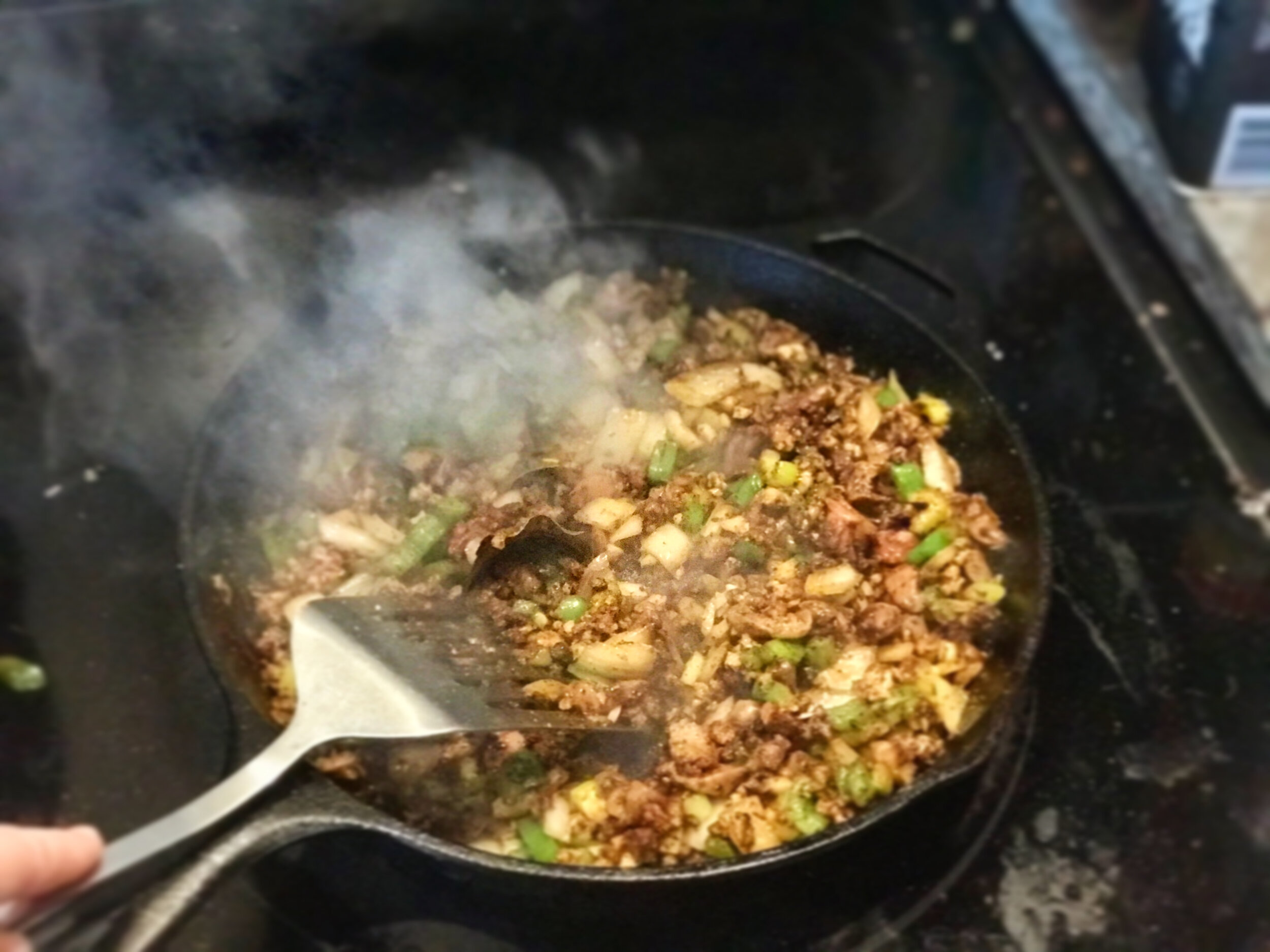HOLY TRINITY, DIRTY RICE: AN ODE TO CAJUN COOKING
All photos courtesy of the author.
Adapted from Chef Paul Prudhomme’s Louisiana Kitchen
Total prep and cook time: Approx. 2 hours Serves: 6
Ingredients:
3 teaspoons cayenne pepper (scale it back a bit if you don’t enjoy spice)
1 ½ teaspoons salt
1 ½ teaspoons black pepper
1 ½ teaspoons sweet paprika
1 teaspoon dry ground mustard
1 teaspoon ground cumin
1 teaspoon dried thyme leaves
1 teaspoon dried oregano leaves
2 bay leaves
2 tablespoons olive or vegetable oil
½ large white onion, diced
3 stalks celery, diced
1 green bell pepper, de-seeded and diced
3-4 cloves garlic, minced
2 tablespoons unsalted butter
½ pound chicken gizzards, chopped
¼ pound ground pork
1 pound chicken livers, chopped
2 cups chicken stock
1 cup uncooked rice
Directions:
Combine seasonings, except for bay leaves, and set aside.
Heat oil in a large skillet over high heat, then add the gizzards, pork, and bay leaves. Cook until meat is thoroughly browned, 6-10 minutes depending on the heat of the pan. Stir occasionally.
Stir in the seasonings, then add the celery, bell pepper, onion, and garlic. Stir well and scrape the bottom of the pan as you go.
Add the butter and stir until melted, then reduce heat to medium and cook for 8-10 minutes, stirring constantly.
Add the stock and stir, scraping the pan to loosen anything stuck to the bottom. Cook over high heat for about 8 minutes, stirring once or twice.
Add the chicken livers and cook for 2 minutes, then add the rice and mix well.
Cover the pan and turn the heat to low. Cook for 5 minutes, then remove the pan from heat and keep covered for 10-20 minutes, long enough for the rice to finish softening.
Remove bay leaves and serve garnished with green onions if desired.
The Story Behind The Dish:
In Cajun culture there are two holy trinities. One of them you find at church, the mystical trio of Father, Son, and Holy Spirit that are simultaneously one being and three disparate parts of your salvation.
The other you find in almost any dish you eat: a Louisiana adaptation of a French mirepoix combining onion, celery, and green pepper into a savory base for dishes like gumbo, jambalaya, and my personal favorite, dirty rice.
I didn’t grow up in Cajun Country, but half of my family spent their childhoods there and passed their beloved recipes and techniques on to me. The smell of the holy trinity sizzling in a hot pan makes me long for a home I’ve never lived in, which would be strange if I wasn’t familiar with the concept from Christianity itself. If heaven is a place we’ve never known, but the Holy Spirit simultaneously lives there and within us, it stands to reason that we could sense paradise in the rare instances that it shows itself. For my part, I hope that heaven has cypress trees.
Dirty rice gets its name in large part from its appearance, which is nothing to gaze upon in wonder. (The photo I’ve included is jazzed up with green onions, a wholly unnecessary garnish on a normal day when I eat my portion straight from the pan.) Dirty is also an apt description in that, historically, the dish is made with scraps of meat from other meals. Today it’s not uncommon to find dirty rice prepared with just ground pork, but I prefer to add chicken giblets and livers in an ode to tradition. Plus, the livers add a mild sweetness that contrasts with the sharp spices and char.
Like most of my favorite dishes, dirty rice is forgiving in the sense that you can adjust the amounts of meat and vegetables and spices to suit your tastes. The recipe I share here is a simplified version of Chef Paul Prudhomme’s dirty rice, adjusted so that I don’t have small portions of green pepper and chicken livers laying around my kitchen, waiting for a purpose.
The most important thing to remember when making dirty rice (or any Cajun dish, really) is that you can’t be afraid to use high heat. Everything will stick to the bottom of the pan, and it’s supposed to so that you can scrape up the cooked-on bits as you deglaze with the chicken broth. The dark color you’ll get may not be appetizing at first glance, but the flavor is out of this world.



